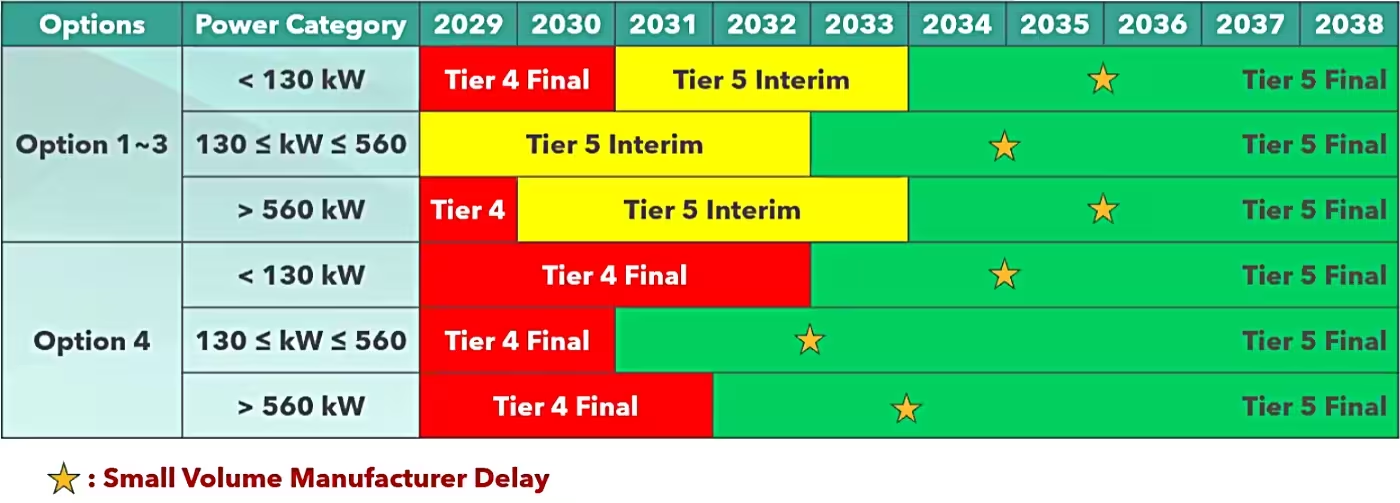CARB releases proposed Tier 5 off-road engine emission standards
8 October 2024
The California Air Resources Board (CARB) held today another workshop meeting to discuss the proposed Tier 5 emission standards for off-road diesel engines. Before the workshop, the agency released the Draft Proposed Regulation Order, dated September 24th.
The workshop focused on changes to the proposed Tier 5 provisions introduced since October 2023. Most of the changes and updates were related to the off-road onboard diagnostic system (OR OBD) and to several other compliance details—there were no changes to the emission limits and implementation dates considered at the previous Tier 5 workshop.
The Tier 5 regulation would be phased-in between 2029 and 2034. Engine manufacturers would choose one of four compliance options that allow phase-in flexibility and the use of emission credits. Three of these compliance options involve a set of Tier 5 interim standards, as shown below.

The Tier 5 interim (Tier 5i) compliance options are:
- Direct compliance with Tier 5i standards without emission credits.
- 50% of engine sales within a power category at the Tier 5 final (Tier 5f) level and 50% at the Tier 4 final (Tier 4f) level.
- Direct compliance with Tier 5i standards using emission credits.
- Longer continuance of Tier 4f compliant engines (up to 5% of manufacturer’s California production volume for up to five MYs) in exchange for earlier introduction of Tier 5f compliant engines.
A large part of the workshop was devoted to the updated OBD and OBMD (on-board monitoring and diagnostics) requirements. Some of the updates to the OBD proposal include:
- All engines fitted with SCR or tailpipe NOx sensors must to be equipped with OBMD system that requires NOx monitoring.
- Only the SAE J1939 communication protocol is allowed, J1979-2 in no longer acceptable.
- A list of specific parameters has been added to data stream requirements.
- More components are added to OBMD, including the DOC and the closed crankcase ventilation system.
- Changes are introduced in OBMD emission thresholds for NOx and PM.
- Changes are introduced in provisions for OBM NOx monitor demonstration testing and malfunction detection testing.
The Tier 5 proposal introduces a new certification pathway for hydrogen-fueled internal combustion engines (ICE). Off-road H2-ICEs of MY 2029 and later would be required to certify as compression ignition (CI) engines if they employ boosted air induction or the H2-ICE engine is designed to operate in equipment historically powered with an off-road CI engine.
This approach is designed to ensure that H2-ICEs that replace diesel engines would be certified to Tier 5 standards, while allowing applications historically powered by naturally-aspirated large spark-ignited (LSI) engines to certify to the LSI standards.
H2-ICEs would generate emission credits for criteria pollutants, but would not generate CO2 credits, as the H2 ICE does not meet CARB zero emission (ZE) criteria.
Several changes have been introduced to the California emissions averaging, banking, and trading (CA-ABT) system. One of the changes would limit the generation of Tier 5 NOx and PM emission credits to engines above 130 kW. This change is intended to promote faster transition to ZE (i.e., battery-electric) equipment in the power category below 130 kW.
Among other changes, the Tier 5 proposal aligns California regulations with the federal definition of an ‘engine’ [40 CFR 1068.30] to include both complete and partially complete engines.
Engine testing requirements have not been discussed—CARB plans to release the draft Tier 5 testing procedure in the 4th quarter 2024.
The agency expects to release the Initial Statement of Reasons and the 45-day public notice for the rule in August 2025 and to consider the Tier 5 regulation at the Board hearing in October 2025.
Source: CARB